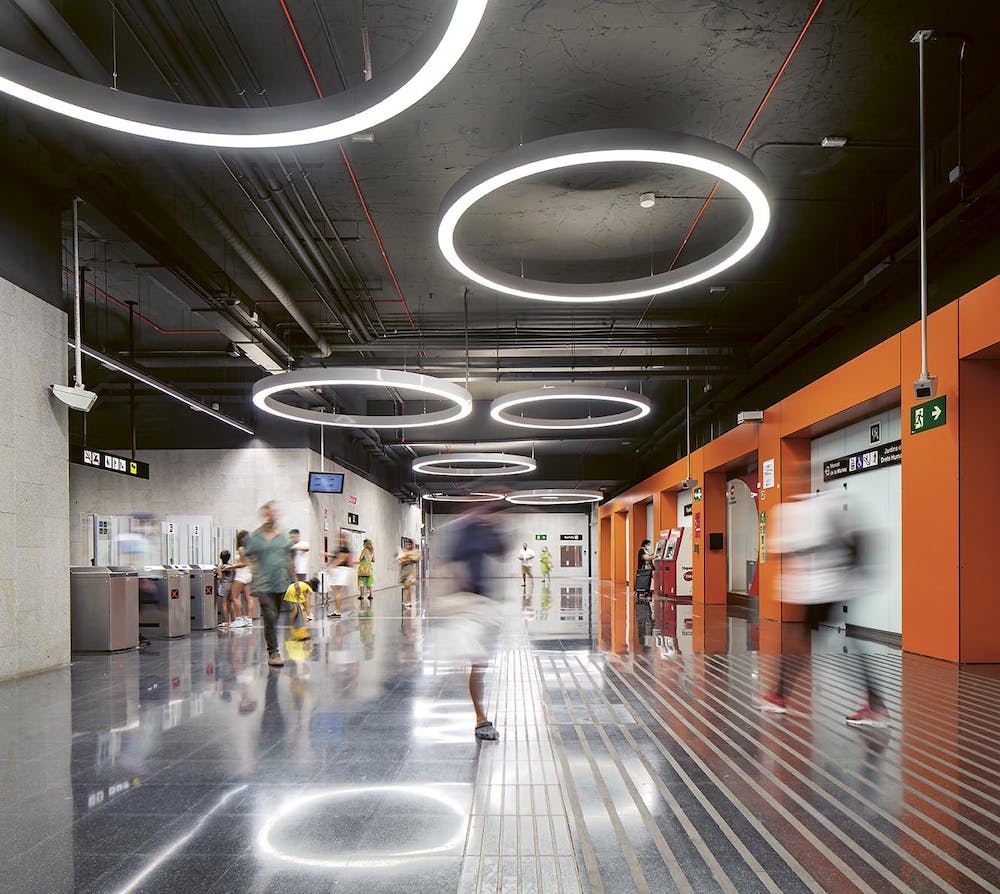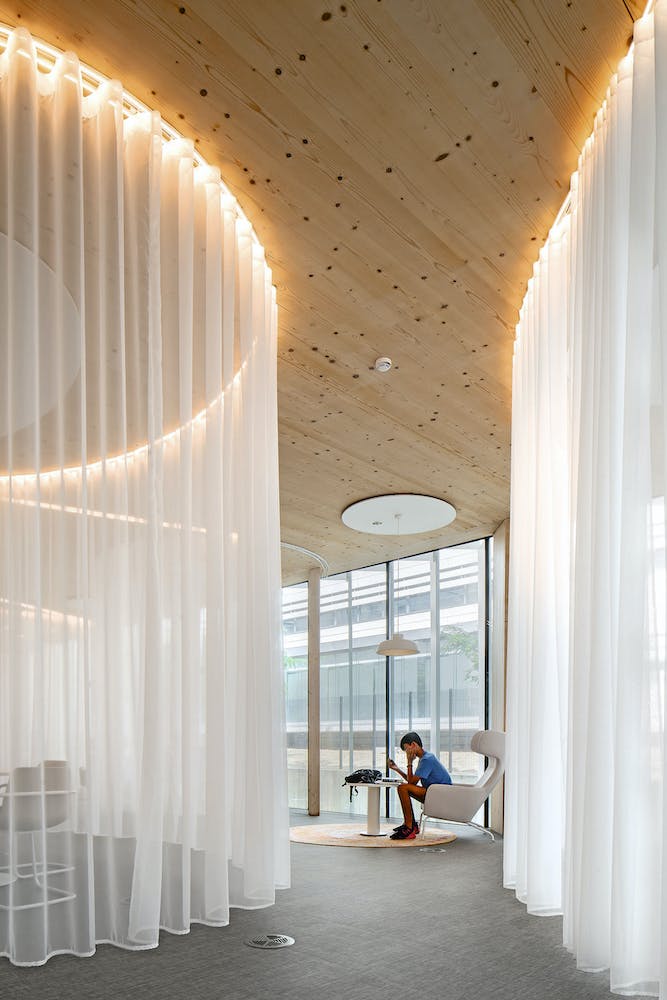Loading
The interiors
Pol Viladoms
Gabriel García Márquez Library
C/Treball, 219. Sant Martí

Gabriel García Márquez Library
C/Treball, 219. Sant Martí

Gabriel García Márquez Library
C/Treball, 219. Sant Martí

Camp del Ferro Municipal Sports Centre
Pl. d'Albert Badia i Mur, 1. Sant Andreu

Camp del Ferro Municipal Sports Centre
Pl. d'Albert Badia i Mur, 1. Sant Andreu

Canòdrom Meridiana former greyhound stadium
C/Concepció Arenal, 165. Sant Andreu

New Metro stations. Foneria
Foneria. Sants-Montjuïc

La Model
C/Entença, 155. L’Eixample

Old Mercedes-Benz factory
C/Sant Adrià, 67. Sant Andreu

La Model
C/Entença, 155. L’Eixample

Plaça de Sóller park
Pl. Sóller, 1. Nou Barris

School of Audiovisual Media (EMAV)
Gran via de les Corts Catalanes, 173-175. Sants-Montjuïc

Plaça de Sóller park
Pl. Sóller, 1. Nou Barris

Ca l'Alier
C/Pere IV, 362. Sant Martí

Turó de la Peira Municipal Sports Centre
C/Sant Iscle, 50. Nou Barris

Old Mercedes-Benz factory
C/Sant Adrià, 67. Sant Andreu

Old Mercedes-Benz factory
C/Sant Adrià, 67. Sant Andreu

Plaça de Sóller park
Pl. Sóller, 1. Nou Barris

Porta Trinitat
Ctra. Ribes, 51-65. Sant Andreu

LGTBI Centre
C/Comte Borrell, 20-24. L’Eixample

Canòdrom Meridiana former greyhound stadium
C/Concepció Arenal, 165. Sant Andreu

Canòdrom Meridiana former greyhound stadium
C/Concepció Arenal, 165. Sant Andreu

Porta Trinitat
Ctra. Ribes, 51-65. Sant Andreu

New Metro stations. Zal / Riu Vell
ZAL / Riu Vell. Sants-Montjuïc

New Metro stations. Foneria
Foneria. Sants-Montjuïc

Camp del Ferro Municipal Sports Centre
Pl. d'Albert Badia i Mur, 1. Sant Andreu

Diagonal-Besòs University Campus
Av. Eduard Maristany. Sant Martí

Plaça de Sóller park
Pl. Sóller, 1. Nou Barris

Camp del Ferro Municipal Sports Centre
Pl. d'Albert Badia i Mur, 1. Sant Andreu

Ca l'Alier
C/Pere IV, 362. Sant Martí

New Metro stations. Foneria
Foneria. Sants-Montjuïc

Ca l'Alier
C/Pere IV, 362. Sant Martí

Porta Trinitat
Ctra. Ribes, 51-65. Sant Andreu

Gabriel García Márquez Library
C/Treball, 219. Sant Martí

New Metro stations. Zal / Riu Vell
ZAL / Riu Vell. Sants-Montjuïc

New Metro stations. Zal / Riu Vell
ZAL / Riu Vell. Sants-Montjuïc

LGTBI Centre
C/Comte Borrell, 20-24. L’Eixample

Ca l'Alier
C/Pere IV, 362. Sant Martí

Gabriel García Márquez Library
C/Treball, 219. Sant Martí

Porta Trinitat
Ctra. Ribes, 51-65. Sant Andreu

Gabriel García Márquez Library
C/Treball, 219. Sant Martí

LGTBI Centre
C/Comte Borrell, 20-24. L’Eixample

[{"image":{"large":{"url":"https://images.prismic.io/surveybcn/pvi_biblioteca_gabriel_garcia_marquez_63.jpg?auto=compress,format&rect=0,0,1309,1637&w=1309&h=1637","localUrl":"/surveyfotografic/common/images/pvi_biblioteca_gabriel_garcia_marquez_63.jpg","width":1309,"height":1637},"scaled":{"url":"https://images.prismic.io/surveybcn/pvi_biblioteca_gabriel_garcia_marquez_63.jpg?auto=compress,format&rect=0,0,1309,1636&w=800&h=1000","localUrl":"/surveyfotografic/common/images/pvi_biblioteca_gabriel_garcia_marquez_63_s.jpg","width":800,"height":1000}},"project":{"meta":{"url":"/surveyfotografic/en/project/biblioteca_gabriel_garcia_marquez"},"body":{"name":"Gabriel García Márquez Library","address":"C/Treball, 219. Sant Martí"}}},{"image":{"large":{"url":"https://images.prismic.io/surveybcn/pvi_biblioteca_gabriel_garcia_marquez_02_64.jpg?auto=compress,format&rect=0,0,1297,1449&w=1297&h=1449","localUrl":"/surveyfotografic/common/images/pvi_biblioteca_gabriel_garcia_marquez_02_64.jpg","width":1297,"height":1449},"scaled":{"url":"https://images.prismic.io/surveybcn/pvi_biblioteca_gabriel_garcia_marquez_02_64.jpg?auto=compress,format&rect=0,0,1297,1449&w=895&h=1000","localUrl":"/surveyfotografic/common/images/pvi_biblioteca_gabriel_garcia_marquez_02_64_s.jpg","width":895,"height":1000}},"project":{"meta":{"url":"/surveyfotografic/en/project/biblioteca_gabriel_garcia_marquez"},"body":{"name":"Gabriel García Márquez Library","address":"C/Treball, 219. Sant Martí"}}},{"image":{"large":{"url":"https://images.prismic.io/surveybcn/pvi_biblioteca_gabriel_garcia_marquez_03_65.jpg?auto=compress,format&rect=0,0,1346,1222&w=1346&h=1222","localUrl":"/surveyfotografic/common/images/pvi_biblioteca_gabriel_garcia_marquez_03_65.jpg","width":1346,"height":1222},"scaled":{"url":"https://images.prismic.io/surveybcn/pvi_biblioteca_gabriel_garcia_marquez_03_65.jpg?auto=compress,format&rect=0,0,1346,1222&w=1000&h=908","localUrl":"/surveyfotografic/common/images/pvi_biblioteca_gabriel_garcia_marquez_03_65_s.jpg","width":1000,"height":908}},"project":{"meta":{"url":"/surveyfotografic/en/project/biblioteca_gabriel_garcia_marquez"},"body":{"name":"Gabriel García Márquez Library","address":"C/Treball, 219. Sant Martí"}}},{"image":{"large":{"url":"https://images.prismic.io/surveybcn/pvi_poliesportiu_camp_del_ferro_53.jpg?auto=compress,format&rect=0,0,1358,975&w=1358&h=975","localUrl":"/surveyfotografic/common/images/pvi_poliesportiu_camp_del_ferro_53.jpg","width":1358,"height":975},"scaled":{"url":"https://images.prismic.io/surveybcn/pvi_poliesportiu_camp_del_ferro_53.jpg?auto=compress,format&rect=0,0,1358,975&w=1000&h=718","localUrl":"/surveyfotografic/common/images/pvi_poliesportiu_camp_del_ferro_53_s.jpg","width":1000,"height":718}},"project":{"meta":{"url":"/surveyfotografic/en/project/camp_del_ferro"},"body":{"name":"Camp del Ferro Municipal Sports Centre","address":"Pl. d'Albert Badia i Mur, 1. Sant Andreu"}}},{"image":{"large":{"url":"https://images.prismic.io/surveybcn/pvi_poliesportiu_camp_del_ferro_02_54.jpg?auto=compress,format&rect=0,0,1351,952&w=1351&h=952","localUrl":"/surveyfotografic/common/images/pvi_poliesportiu_camp_del_ferro_02_54.jpg","width":1351,"height":952},"scaled":{"url":"https://images.prismic.io/surveybcn/pvi_poliesportiu_camp_del_ferro_02_54.jpg?auto=compress,format&rect=0,0,1350,952&w=1000&h=705","localUrl":"/surveyfotografic/common/images/pvi_poliesportiu_camp_del_ferro_02_54_s.jpg","width":1000,"height":705}},"project":{"meta":{"url":"/surveyfotografic/en/project/camp_del_ferro"},"body":{"name":"Camp del Ferro Municipal Sports Centre","address":"Pl. d'Albert Badia i Mur, 1. Sant Andreu"}}},{"image":{"large":{"url":"https://images.prismic.io/surveybcn/pvi_canodrom_76.jpg?auto=compress,format&rect=0,0,1311,1282&w=1311&h=1282","localUrl":"/surveyfotografic/common/images/pvi_canodrom_76.jpg","width":1311,"height":1282},"scaled":{"url":"https://images.prismic.io/surveybcn/pvi_canodrom_76.jpg?auto=compress,format&rect=0,0,1311,1282&w=1000&h=978","localUrl":"/surveyfotografic/common/images/pvi_canodrom_76_s.jpg","width":1000,"height":978}},"project":{"meta":{"url":"/surveyfotografic/en/project/canodrom_meridiana"},"body":{"name":"Canòdrom Meridiana former greyhound stadium","address":"C/Concepció Arenal, 165. Sant Andreu"}}},{"image":{"large":{"url":"https://images.prismic.io/surveybcn/pvi_estacio_foneria_343.jpg?auto=compress,format&rect=0,0,1330,1189&w=1330&h=1189","localUrl":"/surveyfotografic/common/images/pvi_estacio_foneria_343.jpg","width":1330,"height":1189},"scaled":{"url":"https://images.prismic.io/surveybcn/pvi_estacio_foneria_343.jpg?auto=compress,format&rect=0,0,1330,1189&w=1000&h=894","localUrl":"/surveyfotografic/common/images/pvi_estacio_foneria_343_s.jpg","width":1000,"height":894}},"project":{"meta":{"url":"/surveyfotografic/en/project/metro_foneria"},"body":{"name":"New Metro stations. Foneria","address":"Foneria. Sants-Montjuïc"}}},{"image":{"large":{"url":"https://images.prismic.io/surveybcn/pvi_la_model_228.jpg?auto=compress,format&rect=0,0,1335,1690&w=1335&h=1690","localUrl":"/surveyfotografic/common/images/pvi_la_model_228.jpg","width":1335,"height":1690},"scaled":{"url":"https://images.prismic.io/surveybcn/pvi_la_model_228.jpg?auto=compress,format&rect=0,0,1335,1690&w=790&h=1000","localUrl":"/surveyfotografic/common/images/pvi_la_model_228_s.jpg","width":790,"height":1000}},"project":{"meta":{"url":"/surveyfotografic/en/project/la_model"},"body":{"name":"La Model","address":"C/Entença, 155. L’Eixample"}}},{"image":{"large":{"url":"https://images.prismic.io/surveybcn/pvi_antiga_fabrica_mercedes-benz_476.jpg?auto=compress,format&rect=0,0,1340,1067&w=1340&h=1067","localUrl":"/surveyfotografic/common/images/pvi_antiga_fabrica_mercedes-benz_476.jpg","width":1340,"height":1067},"scaled":{"url":"https://images.prismic.io/surveybcn/pvi_antiga_fabrica_mercedes-benz_476.jpg?auto=compress,format&rect=0,0,1340,1067&w=1000&h=796","localUrl":"/surveyfotografic/common/images/pvi_antiga_fabrica_mercedes-benz_476_s.jpg","width":1000,"height":796}},"project":{"meta":{"url":"/surveyfotografic/en/project/antiga_fabrica_mercedes_benz"},"body":{"name":"Old Mercedes-Benz factory","address":"C/Sant Adrià, 67. Sant Andreu"}}},{"image":{"large":{"url":"https://images.prismic.io/surveybcn/pvi_la_model_02_229.jpg?auto=compress,format&rect=0,0,1336,1440&w=1336&h=1440","localUrl":"/surveyfotografic/common/images/pvi_la_model_02_229.jpg","width":1336,"height":1440},"scaled":{"url":"https://images.prismic.io/surveybcn/pvi_la_model_02_229.jpg?auto=compress,format&rect=0,0,1336,1440&w=928&h=1000","localUrl":"/surveyfotografic/common/images/pvi_la_model_02_229_s.jpg","width":928,"height":1000}},"project":{"meta":{"url":"/surveyfotografic/en/project/la_model"},"body":{"name":"La Model","address":"C/Entença, 155. L’Eixample"}}},{"image":{"large":{"url":"https://images.prismic.io/surveybcn/pvi_placa_de_soller_243.jpg?auto=compress,format&rect=0,0,1575,1179&w=1575&h=1179","localUrl":"/surveyfotografic/common/images/pvi_placa_de_soller_243.jpg","width":1575,"height":1179},"scaled":{"url":"https://images.prismic.io/surveybcn/pvi_placa_de_soller_243.jpg?auto=compress,format&rect=0,0,1574,1179&w=1000&h=749","localUrl":"/surveyfotografic/common/images/pvi_placa_de_soller_243_s.jpg","width":1000,"height":749}},"project":{"meta":{"url":"/surveyfotografic/en/project/parc_placa_soller"},"body":{"name":"Plaça de Sóller park","address":"Pl. Sóller, 1. Nou Barris"}}},{"image":{"large":{"url":"https://images.prismic.io/surveybcn/pvi_emav._can_batllo_27.jpg?auto=compress,format&rect=0,0,1578,921&w=1578&h=921","localUrl":"/surveyfotografic/common/images/pvi_emav._can_batllo_27.jpg","width":1578,"height":921},"scaled":{"url":"https://images.prismic.io/surveybcn/pvi_emav._can_batllo_27.jpg?auto=compress,format&rect=0,0,1577,921&w=1000&h=584","localUrl":"/surveyfotografic/common/images/pvi_emav._can_batllo_27_s.jpg","width":1000,"height":584}},"project":{"meta":{"url":"/surveyfotografic/en/project/escola_mitjans_audiovisuals"},"body":{"name":"School of Audiovisual Media (EMAV)","address":"Gran via de les Corts Catalanes, 173-175. Sants-Montjuïc"}}},{"image":{"large":{"url":"https://images.prismic.io/surveybcn/pvi_placa_de_soller_02_244.jpg?auto=compress,format&rect=0,0,1294,1496&w=1294&h=1496","localUrl":"/surveyfotografic/common/images/pvi_placa_de_soller_02_244.jpg","width":1294,"height":1496},"scaled":{"url":"https://images.prismic.io/surveybcn/pvi_placa_de_soller_02_244.jpg?auto=compress,format&rect=0,0,1294,1496&w=865&h=1000","localUrl":"/surveyfotografic/common/images/pvi_placa_de_soller_02_244_s.jpg","width":865,"height":1000}},"project":{"meta":{"url":"/surveyfotografic/en/project/parc_placa_soller"},"body":{"name":"Plaça de Sóller park","address":"Pl. Sóller, 1. Nou Barris"}}},{"image":{"large":{"url":"https://images.prismic.io/surveybcn/pvi_ca_l_alier_461.jpg?auto=compress,format&rect=0,0,1357,1300&w=1357&h=1300","localUrl":"/surveyfotografic/common/images/pvi_ca_l_alier_461.jpg","width":1357,"height":1300},"scaled":{"url":"https://images.prismic.io/surveybcn/pvi_ca_l_alier_461.jpg?auto=compress,format&rect=0,0,1357,1300&w=1000&h=958","localUrl":"/surveyfotografic/common/images/pvi_ca_l_alier_461_s.jpg","width":1000,"height":958}},"project":{"meta":{"url":"/surveyfotografic/en/project/ca_lalier"},"body":{"name":"Ca l'Alier","address":"C/Pere IV, 362. Sant Martí"}}},{"image":{"large":{"url":"https://images.prismic.io/surveybcn/pvi_piscina_turo_de_la_peira_46.jpg?auto=compress,format&rect=0,0,1371,1546&w=1371&h=1546","localUrl":"/surveyfotografic/common/images/pvi_piscina_turo_de_la_peira_46.jpg","width":1371,"height":1546},"scaled":{"url":"https://images.prismic.io/surveybcn/pvi_piscina_turo_de_la_peira_46.jpg?auto=compress,format&rect=0,0,1371,1546&w=887&h=1000","localUrl":"/surveyfotografic/common/images/pvi_piscina_turo_de_la_peira_46_s.jpg","width":887,"height":1000}},"project":{"meta":{"url":"/surveyfotografic/en/project/cem_turo_de_la_peira"},"body":{"name":"Turó de la Peira Municipal Sports Centre","address":"C/Sant Iscle, 50. Nou Barris"}}},{"image":{"large":{"url":"https://images.prismic.io/surveybcn/pvi_antiga_mercedes_03_478.jpg?auto=compress,format&rect=0,0,1773,2489&w=1773&h=2489","localUrl":"/surveyfotografic/common/images/pvi_antiga_mercedes_03_478.jpg","width":1773,"height":2489},"scaled":{"url":"https://images.prismic.io/surveybcn/pvi_antiga_mercedes_03_478.jpg?auto=compress,format&rect=0,0,1772,2489&w=712&h=1000","localUrl":"/surveyfotografic/common/images/pvi_antiga_mercedes_03_478_s.jpg","width":712,"height":1000}},"project":{"meta":{"url":"/surveyfotografic/en/project/antiga_fabrica_mercedes_benz"},"body":{"name":"Old Mercedes-Benz factory","address":"C/Sant Adrià, 67. Sant Andreu"}}},{"image":{"large":{"url":"https://images.prismic.io/surveybcn/pvi_antiga_mercedes_02_477.jpg?auto=compress,format&rect=0,0,1533,1194&w=1533&h=1194","localUrl":"/surveyfotografic/common/images/pvi_antiga_mercedes_02_477.jpg","width":1533,"height":1194},"scaled":{"url":"https://images.prismic.io/surveybcn/pvi_antiga_mercedes_02_477.jpg?auto=compress,format&rect=0,0,1533,1194&w=1000&h=779","localUrl":"/surveyfotografic/common/images/pvi_antiga_mercedes_02_477_s.jpg","width":1000,"height":779}},"project":{"meta":{"url":"/surveyfotografic/en/project/antiga_fabrica_mercedes_benz"},"body":{"name":"Old Mercedes-Benz factory","address":"C/Sant Adrià, 67. Sant Andreu"}}},{"image":{"large":{"url":"https://images.prismic.io/surveybcn/pvi_placa_soller_02_245.jpg?auto=compress,format&rect=0,0,1115,1194&w=1115&h=1194","localUrl":"/surveyfotografic/common/images/pvi_placa_soller_02_245.jpg","width":1115,"height":1194},"scaled":{"url":"https://images.prismic.io/surveybcn/pvi_placa_soller_02_245.jpg?auto=compress,format&rect=0,0,1115,1194&w=934&h=1000","localUrl":"/surveyfotografic/common/images/pvi_placa_soller_02_245_s.jpg","width":934,"height":1000}},"project":{"meta":{"url":"/surveyfotografic/en/project/parc_placa_soller"},"body":{"name":"Plaça de Sóller park","address":"Pl. Sóller, 1. Nou Barris"}}},{"image":{"large":{"url":"https://images.prismic.io/surveybcn/pvi_porta_trinitat_01_90.jpg?auto=compress,format&rect=0,0,1409,955&w=1409&h=955","localUrl":"/surveyfotografic/common/images/pvi_porta_trinitat_01_90.jpg","width":1409,"height":955},"scaled":{"url":"https://images.prismic.io/surveybcn/pvi_porta_trinitat_01_90.jpg?auto=compress,format&rect=0,0,1409,955&w=1000&h=678","localUrl":"/surveyfotografic/common/images/pvi_porta_trinitat_01_90_s.jpg","width":1000,"height":678}},"project":{"meta":{"url":"/surveyfotografic/en/project/porta_trinitat"},"body":{"name":"Porta Trinitat","address":"Ctra. Ribes, 51-65. Sant Andreu"}}},{"image":{"large":{"url":"https://images.prismic.io/surveybcn/pvi_lgtbi_02_38.jpg?auto=compress,format&rect=0,0,1930,1194&w=1930&h=1194","localUrl":"/surveyfotografic/common/images/pvi_lgtbi_02_38.jpg","width":1930,"height":1194},"scaled":{"url":"https://images.prismic.io/surveybcn/pvi_lgtbi_02_38.jpg?auto=compress,format&rect=0,0,1929,1194&w=1000&h=619","localUrl":"/surveyfotografic/common/images/pvi_lgtbi_02_38_s.jpg","width":1000,"height":619}},"project":{"meta":{"url":"/surveyfotografic/en/project/centre_lgtbi"},"body":{"name":"LGTBI Centre","address":"C/Comte Borrell, 20-24. L’Eixample"}}},{"image":{"large":{"url":"https://images.prismic.io/surveybcn/pvi_canodrom_02_77.jpg?auto=compress,format&rect=0,0,1309,955&w=1309&h=955","localUrl":"/surveyfotografic/common/images/pvi_canodrom_02_77.jpg","width":1309,"height":955},"scaled":{"url":"https://images.prismic.io/surveybcn/pvi_canodrom_02_77.jpg?auto=compress,format&rect=0,0,1308,955&w=1000&h=730","localUrl":"/surveyfotografic/common/images/pvi_canodrom_02_77_s.jpg","width":1000,"height":730}},"project":{"meta":{"url":"/surveyfotografic/en/project/canodrom_meridiana"},"body":{"name":"Canòdrom Meridiana former greyhound stadium","address":"C/Concepció Arenal, 165. Sant Andreu"}}},{"image":{"large":{"url":"https://images.prismic.io/surveybcn/pvi_canodrom_03_78.jpg?auto=compress,format&rect=0,0,1194,1194&w=1194&h=1194","localUrl":"/surveyfotografic/common/images/pvi_canodrom_03_78.jpg","width":1194,"height":1194},"scaled":{"url":"https://images.prismic.io/surveybcn/pvi_canodrom_03_78.jpg?auto=compress,format&rect=0,0,1194,1194&w=1000&h=1000","localUrl":"/surveyfotografic/common/images/pvi_canodrom_03_78_s.jpg","width":1000,"height":1000}},"project":{"meta":{"url":"/surveyfotografic/en/project/canodrom_meridiana"},"body":{"name":"Canòdrom Meridiana former greyhound stadium","address":"C/Concepció Arenal, 165. Sant Andreu"}}},{"image":{"large":{"url":"https://images.prismic.io/surveybcn/pvi_porta_trinitat_04_93.jpg?auto=compress,format&rect=0,0,1659,2489&w=1659&h=2489","localUrl":"/surveyfotografic/common/images/pvi_porta_trinitat_04_93.jpg","width":1659,"height":2489},"scaled":{"url":"https://images.prismic.io/surveybcn/pvi_porta_trinitat_04_93.jpg?auto=compress,format&rect=0,0,1659,2487&w=667&h=1000","localUrl":"/surveyfotografic/common/images/pvi_porta_trinitat_04_93_s.jpg","width":667,"height":1000}},"project":{"meta":{"url":"/surveyfotografic/en/project/porta_trinitat"},"body":{"name":"Porta Trinitat","address":"Ctra. Ribes, 51-65. Sant Andreu"}}},{"image":{"large":{"url":"https://images.prismic.io/surveybcn/pvi_metro_zal_02_356.jpg?auto=compress,format&rect=0,0,1541,955&w=1541&h=955","localUrl":"/surveyfotografic/common/images/pvi_metro_zal_02_356.jpg","width":1541,"height":955},"scaled":{"url":"https://images.prismic.io/surveybcn/pvi_metro_zal_02_356.jpg?auto=compress,format&rect=0,0,1540,955&w=1000&h=620","localUrl":"/surveyfotografic/common/images/pvi_metro_zal_02_356_s.jpg","width":1000,"height":620}},"project":{"meta":{"url":"/surveyfotografic/en/project/metro_zal_riu_vell"},"body":{"name":"New Metro stations. Zal / Riu Vell","address":"ZAL / Riu Vell. Sants-Montjuïc"}}},{"image":{"large":{"url":"https://images.prismic.io/surveybcn/pvi_foneria_04_345.jpg?auto=compress,format&rect=0,0,1353,1194&w=1353&h=1194","localUrl":"/surveyfotografic/common/images/pvi_foneria_04_345.jpg","width":1353,"height":1194},"scaled":{"url":"https://images.prismic.io/surveybcn/pvi_foneria_04_345.jpg?auto=compress,format&rect=0,0,1353,1193&w=1000&h=882","localUrl":"/surveyfotografic/common/images/pvi_foneria_04_345_s.jpg","width":1000,"height":882}},"project":{"meta":{"url":"/surveyfotografic/en/project/metro_foneria"},"body":{"name":"New Metro stations. Foneria","address":"Foneria. Sants-Montjuïc"}}},{"image":{"large":{"url":"https://images.prismic.io/surveybcn/pvi_camp_ferro_03_55.jpg?auto=compress,format&rect=0,0,1206,955&w=1206&h=955","localUrl":"/surveyfotografic/common/images/pvi_camp_ferro_03_55.jpg","width":1206,"height":955},"scaled":{"url":"https://images.prismic.io/surveybcn/pvi_camp_ferro_03_55.jpg?auto=compress,format&rect=0,0,1206,955&w=1000&h=792","localUrl":"/surveyfotografic/common/images/pvi_camp_ferro_03_55_s.jpg","width":1000,"height":792}},"project":{"meta":{"url":"/surveyfotografic/en/project/camp_del_ferro"},"body":{"name":"Camp del Ferro Municipal Sports Centre","address":"Pl. d'Albert Badia i Mur, 1. Sant Andreu"}}},{"image":{"large":{"url":"https://images.prismic.io/surveybcn/pvi_campus_diagonal_besos_01_400.jpg?auto=compress,format&rect=0,0,801,1194&w=801&h=1194","localUrl":"/surveyfotografic/common/images/pvi_campus_diagonal_besos_01_400.jpg","width":801,"height":1194},"scaled":{"url":"https://images.prismic.io/surveybcn/pvi_campus_diagonal_besos_01_400.jpg?auto=compress,format&rect=0,0,801,1194&w=671&h=1000","localUrl":"/surveyfotografic/common/images/pvi_campus_diagonal_besos_01_400_s.jpg","width":671,"height":1000}},"project":{"meta":{"url":"/surveyfotografic/en/project/campus_diagonal_besos"},"body":{"name":"Diagonal-Besòs University Campus","address":"Av. Eduard Maristany. Sant Martí"}}},{"image":{"large":{"url":"https://images.prismic.io/surveybcn/pvi_placa_soller_03_246.jpg?auto=compress,format&rect=0,0,942,1194&w=942&h=1194","localUrl":"/surveyfotografic/common/images/pvi_placa_soller_03_246.jpg","width":942,"height":1194},"scaled":{"url":"https://images.prismic.io/surveybcn/pvi_placa_soller_03_246.jpg?auto=compress,format&rect=0,0,942,1194&w=789&h=1000","localUrl":"/surveyfotografic/common/images/pvi_placa_soller_03_246_s.jpg","width":789,"height":1000}},"project":{"meta":{"url":"/surveyfotografic/en/project/parc_placa_soller"},"body":{"name":"Plaça de Sóller park","address":"Pl. Sóller, 1. Nou Barris"}}},{"image":{"large":{"url":"https://images.prismic.io/surveybcn/pvi_camp_ferro_04_56.jpg?auto=compress,format&rect=0,0,2658,2489&w=2658&h=2489","localUrl":"/surveyfotografic/common/images/pvi_camp_ferro_04_56.jpg","width":2658,"height":2489},"scaled":{"url":"https://images.prismic.io/surveybcn/pvi_camp_ferro_04_56.jpg?auto=compress,format&rect=0,0,2658,2488&w=1000&h=936","localUrl":"/surveyfotografic/common/images/pvi_camp_ferro_04_56_s.jpg","width":1000,"height":936}},"project":{"meta":{"url":"/surveyfotografic/en/project/camp_del_ferro"},"body":{"name":"Camp del Ferro Municipal Sports Centre","address":"Pl. d'Albert Badia i Mur, 1. Sant Andreu"}}},{"image":{"large":{"url":"https://images.prismic.io/surveybcn/pvi_ca_l_alier_02_462.jpg?auto=compress,format&rect=0,0,767,955&w=767&h=955","localUrl":"/surveyfotografic/common/images/pvi_ca_l_alier_02_462.jpg","width":767,"height":955},"scaled":{"url":"https://images.prismic.io/surveybcn/pvi_ca_l_alier_02_462.jpg?auto=compress,format&rect=0,0,767,955&w=803&h=1000","localUrl":"/surveyfotografic/common/images/pvi_ca_l_alier_02_462_s.jpg","width":803,"height":1000}},"project":{"meta":{"url":"/surveyfotografic/en/project/ca_lalier"},"body":{"name":"Ca l'Alier","address":"C/Pere IV, 362. Sant Martí"}}},{"image":{"large":{"url":"https://images.prismic.io/surveybcn/pvi_foneria_02_344.jpg?auto=compress,format&rect=0,0,1187,1194&w=1187&h=1194","localUrl":"/surveyfotografic/common/images/pvi_foneria_02_344.jpg","width":1187,"height":1194},"scaled":{"url":"https://images.prismic.io/surveybcn/pvi_foneria_02_344.jpg?auto=compress,format&rect=0,0,1187,1194&w=994&h=1000","localUrl":"/surveyfotografic/common/images/pvi_foneria_02_344_s.jpg","width":994,"height":1000}},"project":{"meta":{"url":"/surveyfotografic/en/project/metro_foneria"},"body":{"name":"New Metro stations. Foneria","address":"Foneria. Sants-Montjuïc"}}},{"image":{"large":{"url":"https://images.prismic.io/surveybcn/pvi_ca_l_alier_05_464.jpg?auto=compress,format&rect=0,0,2704,2489&w=2704&h=2489","localUrl":"/surveyfotografic/common/images/pvi_ca_l_alier_05_464.jpg","width":2704,"height":2489},"scaled":{"url":"https://images.prismic.io/surveybcn/pvi_ca_l_alier_05_464.jpg?auto=compress,format&rect=0,0,2704,2488&w=1000&h=920","localUrl":"/surveyfotografic/common/images/pvi_ca_l_alier_05_464_s.jpg","width":1000,"height":920}},"project":{"meta":{"url":"/surveyfotografic/en/project/ca_lalier"},"body":{"name":"Ca l'Alier","address":"C/Pere IV, 362. Sant Martí"}}},{"image":{"large":{"url":"https://images.prismic.io/surveybcn/pvi_porta_trinitat_03_92.jpg?auto=compress,format&rect=0,0,1390,955&w=1390&h=955","localUrl":"/surveyfotografic/common/images/pvi_porta_trinitat_03_92.jpg","width":1390,"height":955},"scaled":{"url":"https://images.prismic.io/surveybcn/pvi_porta_trinitat_03_92.jpg?auto=compress,format&rect=0,0,1390,955&w=1000&h=687","localUrl":"/surveyfotografic/common/images/pvi_porta_trinitat_03_92_s.jpg","width":1000,"height":687}},"project":{"meta":{"url":"/surveyfotografic/en/project/porta_trinitat"},"body":{"name":"Porta Trinitat","address":"Ctra. Ribes, 51-65. Sant Andreu"}}},{"image":{"large":{"url":"https://images.prismic.io/surveybcn/pvi_biblioteca_garcia_marquez_05_67.jpg?auto=compress,format&rect=0,0,1210,955&w=1210&h=955","localUrl":"/surveyfotografic/common/images/pvi_biblioteca_garcia_marquez_05_67.jpg","width":1210,"height":955},"scaled":{"url":"https://images.prismic.io/surveybcn/pvi_biblioteca_garcia_marquez_05_67.jpg?auto=compress,format&rect=0,0,1210,955&w=1000&h=789","localUrl":"/surveyfotografic/common/images/pvi_biblioteca_garcia_marquez_05_67_s.jpg","width":1000,"height":789}},"project":{"meta":{"url":"/surveyfotografic/en/project/biblioteca_gabriel_garcia_marquez"},"body":{"name":"Gabriel García Márquez Library","address":"C/Treball, 219. Sant Martí"}}},{"image":{"large":{"url":"https://images.prismic.io/surveybcn/pvi_metro_zal_03_357.jpg?auto=compress,format&rect=0,0,2703,2489&w=2703&h=2489","localUrl":"/surveyfotografic/common/images/pvi_metro_zal_03_357.jpg","width":2703,"height":2489},"scaled":{"url":"https://images.prismic.io/surveybcn/pvi_metro_zal_03_357.jpg?auto=compress,format&rect=0,0,2702,2489&w=1000&h=921","localUrl":"/surveyfotografic/common/images/pvi_metro_zal_03_357_s.jpg","width":1000,"height":921}},"project":{"meta":{"url":"/surveyfotografic/en/project/metro_zal_riu_vell"},"body":{"name":"New Metro stations. Zal / Riu Vell","address":"ZAL / Riu Vell. Sants-Montjuïc"}}},{"image":{"large":{"url":"https://images.prismic.io/surveybcn/pvi_metro_zal_01_355.jpg?auto=compress,format&rect=0,0,1414,955&w=1414&h=955","localUrl":"/surveyfotografic/common/images/pvi_metro_zal_01_355.jpg","width":1414,"height":955},"scaled":{"url":"https://images.prismic.io/surveybcn/pvi_metro_zal_01_355.jpg?auto=compress,format&rect=0,0,1414,954&w=1000&h=675","localUrl":"/surveyfotografic/common/images/pvi_metro_zal_01_355_s.jpg","width":1000,"height":675}},"project":{"meta":{"url":"/surveyfotografic/en/project/metro_zal_riu_vell"},"body":{"name":"New Metro stations. Zal / Riu Vell","address":"ZAL / Riu Vell. Sants-Montjuïc"}}},{"image":{"large":{"url":"https://images.prismic.io/surveybcn/pvi_lgtbi_04_40.jpg?auto=compress,format&rect=0,0,1166,1194&w=1166&h=1194","localUrl":"/surveyfotografic/common/images/pvi_lgtbi_04_40.jpg","width":1166,"height":1194},"scaled":{"url":"https://images.prismic.io/surveybcn/pvi_lgtbi_04_40.jpg?auto=compress,format&rect=0,0,1166,1193&w=977&h=1000","localUrl":"/surveyfotografic/common/images/pvi_lgtbi_04_40_s.jpg","width":977,"height":1000}},"project":{"meta":{"url":"/surveyfotografic/en/project/centre_lgtbi"},"body":{"name":"LGTBI Centre","address":"C/Comte Borrell, 20-24. L’Eixample"}}},{"image":{"large":{"url":"https://images.prismic.io/surveybcn/pvi_ca_l_alier_04_463.jpg?auto=compress,format&rect=0,0,1462,955&w=1462&h=955","localUrl":"/surveyfotografic/common/images/pvi_ca_l_alier_04_463.jpg","width":1462,"height":955},"scaled":{"url":"https://images.prismic.io/surveybcn/pvi_ca_l_alier_04_463.jpg?auto=compress,format&rect=0,0,1462,955&w=1000&h=653","localUrl":"/surveyfotografic/common/images/pvi_ca_l_alier_04_463_s.jpg","width":1000,"height":653}},"project":{"meta":{"url":"/surveyfotografic/en/project/ca_lalier"},"body":{"name":"Ca l'Alier","address":"C/Pere IV, 362. Sant Martí"}}},{"image":{"large":{"url":"https://images.prismic.io/surveybcn/pvi_biblioteca_garcia_marquez_03_66.jpg?auto=compress,format&rect=0,0,1659,2489&w=1659&h=2489","localUrl":"/surveyfotografic/common/images/pvi_biblioteca_garcia_marquez_03_66.jpg","width":1659,"height":2489},"scaled":{"url":"https://images.prismic.io/surveybcn/pvi_biblioteca_garcia_marquez_03_66.jpg?auto=compress,format&rect=0,0,1659,2487&w=667&h=1000","localUrl":"/surveyfotografic/common/images/pvi_biblioteca_garcia_marquez_03_66_s.jpg","width":667,"height":1000}},"project":{"meta":{"url":"/surveyfotografic/en/project/biblioteca_gabriel_garcia_marquez"},"body":{"name":"Gabriel García Márquez Library","address":"C/Treball, 219. Sant Martí"}}},{"image":{"large":{"url":"https://images.prismic.io/surveybcn/pvi_porta_trinitat_02_91.jpg?auto=compress,format&rect=0,0,1650,2489&w=1650&h=2489","localUrl":"/surveyfotografic/common/images/pvi_porta_trinitat_02_91.jpg","width":1650,"height":2489},"scaled":{"url":"https://images.prismic.io/surveybcn/pvi_porta_trinitat_02_91.jpg?auto=compress,format&rect=0,0,1650,2489&w=663&h=1000","localUrl":"/surveyfotografic/common/images/pvi_porta_trinitat_02_91_s.jpg","width":663,"height":1000}},"project":{"meta":{"url":"/surveyfotografic/en/project/porta_trinitat"},"body":{"name":"Porta Trinitat","address":"Ctra. Ribes, 51-65. Sant Andreu"}}},{"image":{"large":{"url":"https://images.prismic.io/surveybcn/pvi_biblioteca_garcia_marquez_02_68.jpg?auto=compress,format&rect=0,0,2076,2489&w=2076&h=2489","localUrl":"/surveyfotografic/common/images/pvi_biblioteca_garcia_marquez_02_68.jpg","width":2076,"height":2489},"scaled":{"url":"https://images.prismic.io/surveybcn/pvi_biblioteca_garcia_marquez_02_68.jpg?auto=compress,format&rect=0,0,2076,2489&w=834&h=1000","localUrl":"/surveyfotografic/common/images/pvi_biblioteca_garcia_marquez_02_68_s.jpg","width":834,"height":1000}},"project":{"meta":{"url":"/surveyfotografic/en/project/biblioteca_gabriel_garcia_marquez"},"body":{"name":"Gabriel García Márquez Library","address":"C/Treball, 219. Sant Martí"}}},{"image":{"large":{"url":"https://images.prismic.io/surveybcn/pvi_lgtbi_03_39.jpg?auto=compress,format&rect=0,0,1650,1194&w=1650&h=1194","localUrl":"/surveyfotografic/common/images/pvi_lgtbi_03_39.jpg","width":1650,"height":1194},"scaled":{"url":"https://images.prismic.io/surveybcn/pvi_lgtbi_03_39.jpg?auto=compress,format&rect=0,0,1649,1194&w=1000&h=724","localUrl":"/surveyfotografic/common/images/pvi_lgtbi_03_39_s.jpg","width":1000,"height":724}},"project":{"meta":{"url":"/surveyfotografic/en/project/centre_lgtbi"},"body":{"name":"LGTBI Centre","address":"C/Comte Borrell, 20-24. L’Eixample"}}}]
{"columns":[{"type":"picture","pictures":[0],"rows":10},{"type":"picture","pictures":[1],"rows":10},{"type":"picture","pictures":[2,3],"rows":5},{"type":"picture","pictures":[4],"rows":10},{"type":"picture","pictures":[5],"rows":6},{"type":"picture","pictures":[6],"rows":10},{"type":"picture","pictures":[7],"rows":10},{"type":"picture","pictures":[8,9],"rows":5},{"type":"picture","pictures":[10],"rows":10},{"type":"picture","pictures":[11],"rows":10},{"type":"picture","pictures":[12],"rows":10},{"type":"picture","pictures":[13],"rows":10},{"type":"picture","pictures":[14],"rows":10},{"type":"picture","pictures":[15],"rows":10},{"type":"picture","pictures":[16],"rows":10},{"type":"picture","pictures":[17],"rows":10},{"type":"picture","pictures":[18],"rows":10},{"type":"picture","pictures":[19],"rows":10},{"type":"picture","pictures":[20],"rows":6},{"type":"spacer","width":0.153877217580501},{"type":"picture","pictures":[21,22],"rows":5},{"type":"picture","pictures":[23],"rows":6},{"type":"picture","pictures":[24],"rows":10},{"type":"picture","pictures":[25,26],"rows":5},{"type":"picture","pictures":[27],"rows":10},{"type":"picture","pictures":[28,29],"rows":5},{"type":"picture","pictures":[30],"rows":10},{"type":"picture","pictures":[31],"rows":10},{"type":"picture","pictures":[32],"rows":10},{"type":"picture","pictures":[33],"rows":6},{"type":"picture","pictures":[34,35],"rows":5},{"type":"picture","pictures":[36],"rows":10},{"type":"picture","pictures":[37,38],"rows":5},{"type":"picture","pictures":[39],"rows":10},{"type":"picture","pictures":[40],"rows":10},{"type":"picture","pictures":[41],"rows":10}]}

